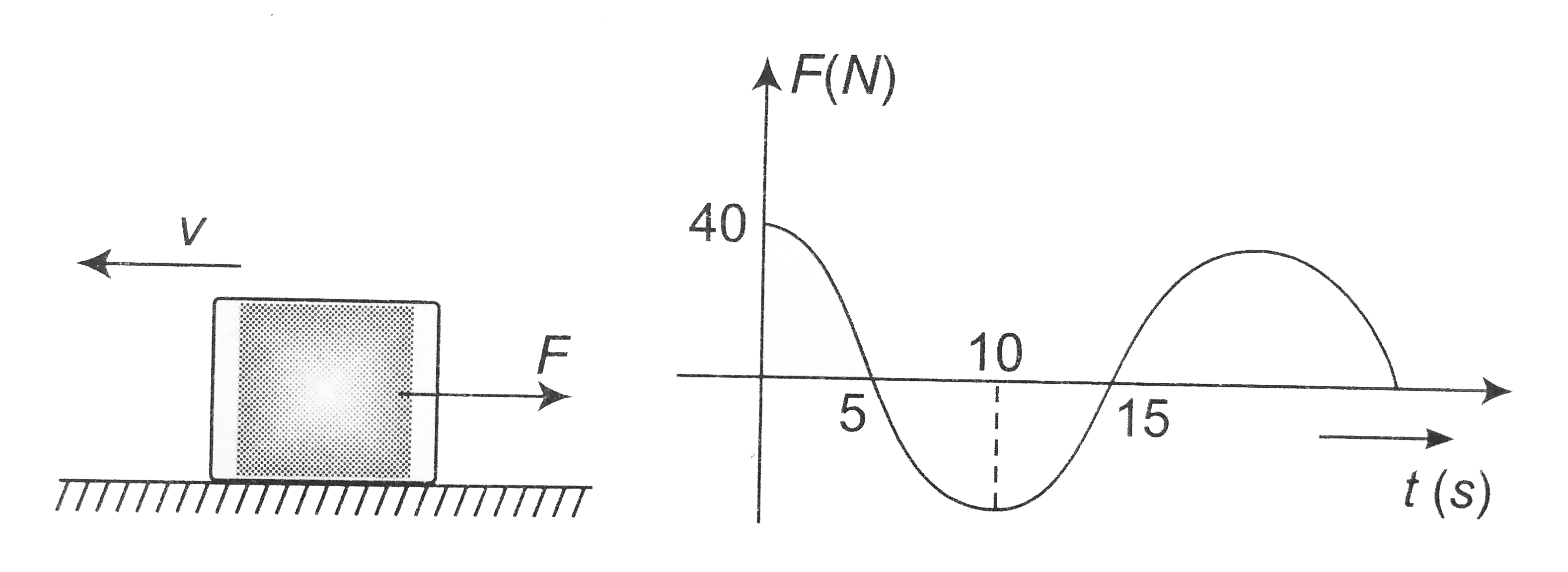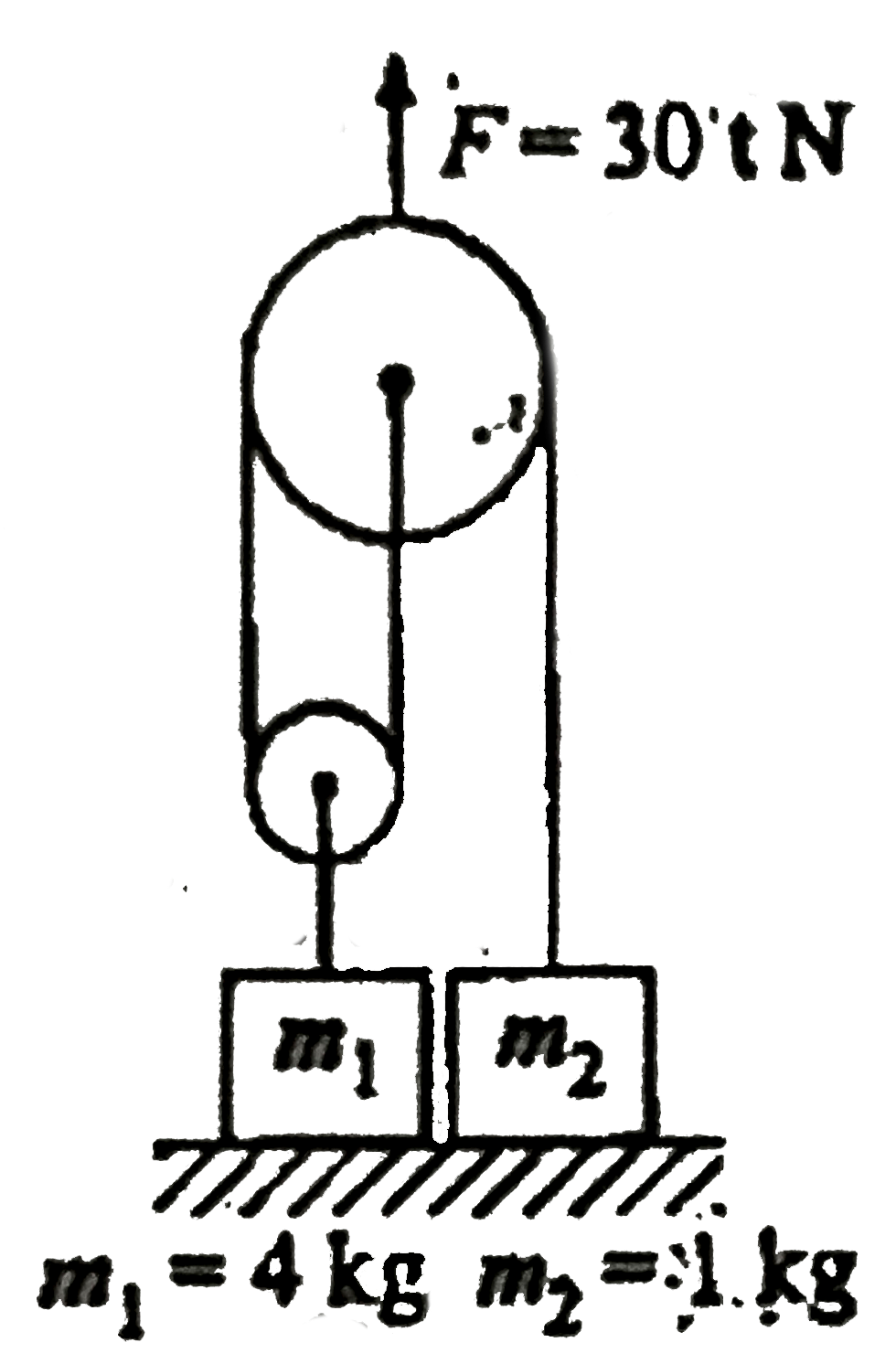The 10kg block is moving to the left with a speed of 1.2m/s at time t=0 A force F is applied kinetic friction is μk=0.2. Determine the time t at which the block comes to a slip. (g=10m/s2)

μkmg=0.2×10×10=20N For t≤0.2s
Retardation a1=F+μkmgm
=20+2010=4m/s2
At the end of 0.2s
v=1.2−4×0.2=0.4m/s
For t>0.2s
Retardation a2=10+2010=3m/s2
Block will come to rest after time
t0=va2=0.43=0.13s
∴ Total time =0.2+0.13=0.33s
Topper's Solved these Questions
- LAWS OF MOTIONBOOK - DC PANDEYCHAPTER - LAWS OF MOTIONEXERCISE - example
86 Videos
- LAWS OF MOTIONBOOK - DC PANDEYCHAPTER - LAWS OF MOTIONEXERCISE - Check point 5.1
20 Videos
- LAWS OF MOTIONBOOK - DC PANDEYCHAPTER - LAWS OF MOTIONEXERCISE - Comprehension
9 Videos
- KINEMATICS 1BOOK - DC PANDEYCHAPTER - KINEMATICS 1EXERCISE - INTEGER_TYPE
15 Videos
- LAWS OF THERMODYNAMICSBOOK - DC PANDEYCHAPTER - LAWS OF THERMODYNAMICSEXERCISE - Level 2 Subjective
18 Videos
Similar Questions
A block of mass 2.00 kg moving at a speed of 10.0 m/s accelerates at 3.0 ms2 for 5.00 s. Compute its final kinetic enegy.
View SolutionBlocks A and B have dimensions as shown in the fig. and their masses are 8 kg and 1 kg respectively. A small block C of mass 0.5 kg is placed on the top left corner of block A. All surfaces are smooth. A horizontal force F = 18 N is applied to the block B at time t = 0. At what time will the block C hit the ground surface? Take g=10m/s2.

View Solution
Knowledge Check
A 15kg block is initially moving along a smooth horizontal surface with a speed of v=4m/s to the left. It is acted by a force F , which varies in the manner shown. Determine the velocity of the block at t=15 seconds.
 A12.5m/sB8.5m/sC20m/sD9.5m/s
A12.5m/sB8.5m/sC20m/sD9.5m/sA block of mass M is sliding down the plane. Coefficient of static friction is μs and kinetic friction is μk. Then friction force acting on the block is :
 A(F+Mg)sinθBμk(F+Mg)cosθCμsMgcosθD(Mg+F)sinθ
A(F+Mg)sinθBμk(F+Mg)cosθCμsMgcosθD(Mg+F)sinθA 0.5kg block slides from the point A on a horizontal track with an initial speed 3m/s towards a weightless horizontal spring of length 1m and force constant 2N/m. The part AB of the track is frictionless and the part BC has the coefficient of static and kinetic friction as '0.22' and 0.20 respectively. If the distances AB and BD are 2m and 2.14m respectively, find total distance through which the block moves before it comes to rest completely. (g=10 m//s^(2) ).
A3.23 mB4.14 mC5.24 mD4.67 m
In the figure shown m1=1kg,m2=2kg, pulley is ideal . At t = 0 , both masses touches the ground and string is tout . A force F = 2t is applied to pulley ( t is in second ) then m1 is lifted off the ground at time ( g = 10 m/s2)

View SolutionA block 'A' of mass 1kg is kept on a block 'B' of mass 2kg .Block A is imparted a velocity of 16m/s at t=0.If the coefficient of friction between A and B is 0.2, find the time (in sec) after which momentum of A and B relative to ground will be equal.(Take g=10m/s^(2) ).
View SolutionA block A of mass 2 kg rests on a horizontal surface. Another block B of mass 1 kg moving at a speed of m/s when at a distance of 16 cm from A. collides elastically with A. The coefficeint of friction between the horizontal surface and earth of the blocks is 0.2. Then (g=10m/s2)
View SolutionForce F is applied on upper pulley. If F = 30 t where t is time in second. Find the time when m1 loses contact with floor : (Take g=10m/s2)

View SolutionA system of two blocks is shown in figure. Friction coefficient between 5 kg and 10 kg block is μ=0.6 and between 10 kg and ground is μ=0.4 What will be the maximum value of force F applied at the lower block so that 5 kg block does not slip w.r.t. 10 kg . (g=10m/sec2). The force applied at the upper block is having fixed magnitude of 80 N (both forces start to act simultaneously)

View Solution